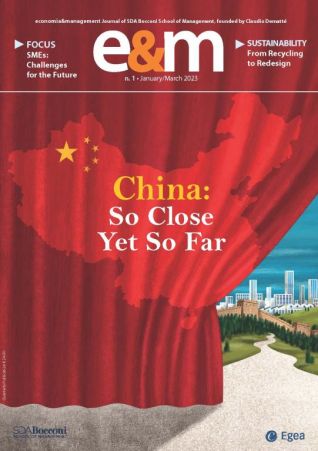E&M
2023/1
The Internationalization of the Chinese Currency
Never as in recent months have investors withdrawn capital from the Chinese financial markets. There are many reasons, that go from the economic situation to the Chinese regulatory context, to the geopolitical crisis. In this situation, there is also the peculiar Chinese monetary policy, that for more than a decade, despite maintaining strict financial control within national borders, has sought to export the renminbi to transform it from a domestic currency into an international one.
The net outflow of capital from China is continuing and getting worse. In recent months, according to data from the International Institute of Finance (IIF), foreign investors have sold their Chinese shares and bonds for a value equivalent to 17 billion dollars, a historic high. This sell-off, driven principally by high outgoing Chinese investments, also during the years of the pandemic, follows almost two consecutive years of net portfolio outflows, including the fourth quarter of 2021, with a capital and financial deficit of 320.6 billion dollars, according to information from the Chinese State Administration of Foreign Exchange. Bonds have suffered the most: data from the Chinese government shows a record withdrawal of foreign investors, equal to 5.5 billion dollars in Chinese state bonds in February, the largest monthly drop ever recorded, according to China Central Depository and Clearing, followed by a new record of over 8 billion dollars in March.
Figure 1 Net capital flows from China

Source: tradingeconomics.com.
Thus, after having rapidly increased their exposure between 2014 and 2018, investors are now abandoning China in an unprecedented way, considering that the last time China experienced such capital flight was between 2015 and 2017, and on that occasion harsh capital controls were needed to stop the outflow. The IIF has spoken of a true and “unprecedented” capital flight by foreign investors, especially because during this period there were no similar outflows from other emerging markets.
It should be noted that, to the contrary, according to data from the Chinese Ministry of Trade, the inflows of foreign direct investment in China reached the record level of 173 billion dollars in 2021, with an increase of 20 percent over the previous year, because the Chinese domestic market, despite growing at lower rates than in the past, is still enormous.
Economic crisis and geopolitical instability
There are four principal reasons for this flight: two internal, and two international.
First of all, the growth prospects for the domestic economy deteriorated in the first quarter of 2022. Although the aggregate figure for the quarter was welcomed as amply positive (4.8 percent compared to the expectation of 4.4 percent), in reality the month of March saw much weaker consumption than the same month of 2021. And March is the most significant of the first three months of the year, because the first two always show strong seasonality due to the Chinese New Year. The International Monetary Fund recently cut its forecast for China’s growth to 4.4 percent, down from 4.8 percent, citing the risks of Beijing’s strict “Zero Covid” policy. The figure is well below China’s official forecast, that comes in at approximately 5.5 percent. The “Zero Covid” policy has worsened growth prospects, and the expansion of the current lockdown, from Shanghai to Beijing, has made foreign investors aware that the pandemic in China is anything but under control.
A second internal reason regards the regulatory and legislative context, that in China is anything but transparent and predictable. Much of the current mistrust of investors in the prospects for the country to become truly attractive on the financial front can be traced to the broad regulatory clamp-down on the private sector, triggered by President Xi Jinping in 2020. There is the fear that this year, the government will continue with curbs on sectors that go from education to technology. A series of rules revealed last July essentially closed the industry of private education, a 120 billion dollar business, putting tens of thousands of companies out of the market. Another decision by regulators, to prohibit DiDi – the largest rider app in the country – a few days after its IPO in the United States, astonished international investors and cost it heavily. The clamp-down led to a strong sell-off of Chinese shares around the world.
Moving on to the external reasons, the most important is certainly the rising of interest rates in other countries, especially in the United States, that makes China not very attractive for investments. And the expectations regarding the differential cannot but increase, given that the Federal Reserve has already announced new hikes, and vice versa, the People’s Bank of China (PBoC) cannot but maintain an expansive policy, given demand conditions. At the beginning of October 2022, yields on 10-year Chinese state bonds fell below yields on US Treasuries for the first time in 12 years.
According to Preqin, a London-based company that analyzes investment data, in the first quarter of 2022 the American funds that invested in China attracted only 1.4 billion dollars, a drop of 70 percent compared to the previous quarter. Another survey, by Bain & Company, showed that private equity funds focused on Great China attracted 28 billion dollars in new financing for the second half of last year, a drop of 54 percent compared to the first half-year, since global investors are increasingly worried about the political and economic uncertainty of the Chinese market.
Finally, on the geopolitical front, the extension of the war in Ukraine and the tightening of the sanctions against Russia, in a context of the country’s “friendship without limits” with China, have increased the likelihood that China could also be affected by sanctions in the future, at least indirectly. Above all anticipating the pressure that Beijing will put on Taiwan in 2023 to favor the pro-China candidate in the primaries, that could reopen tensions in East Asia. Demonstrating the importance of this geopolitical element, portfolio outflows from Taiwan have also intensified recently.
The renminbi towards internationalization
The immediate consequence of the flight of investors, the yuan that has touched a six-month low against the US dollar, will not be enough to offset declining expectations for the performance of economic activity in China, since on the one hand, greater price competitiveness is no longer a driver of Chinese exports, and on the other hand, it makes imports of technology and IP, for which China still has a massive need, more costly.
In this context, how is the Chinese policy of making the renminbi an international currency going? The renminbi today is still a non-convertible currency, i.e. one that does not circulate freely outside of Chinese borders. The internationalization of the renminbi has been a goal of the Beijing government since 2009. Today the impact of this strategy is measured not so much by the still limited scope of the reforms in the Chinese currency and financial sector, but simply by the strong growth of the use of the Chinese currency for payments in China’s international trade: currently approximately 25 percent of these transactions, compared to less than 1 percent in 2009. According to the data published regularly by the Society for Worldwide Interbank Financial Telecommunication (SWIFT), the renminbi is sixth in the rankings of the currencies most used in international payments, with a share of 1.6 percent. This is an extremely modest share, if compared to that of the dollar (40.6 percent) and the euro (33.3 percent). However, fairly liquid and diversified markets now exist for the renminbi, in Hong Kong, London, Singapore, and most of the world’s international financial centers.
Despite this progress, the renminbi is evidently still a currency in evolution, and not a true international currency. It is not a “great currency” like the dollar, whose use extends beyond the area of international transactions. If it is true, to paraphrase the Nobel-prize winning economist Robert Mundell, that “great nations have great currencies,” the absence of a true currency – and thus the need to use the dollar in most international transactions – limits the possibility for China to use the considerable financial resources at its disposal to achieve its economic and political goals. The absence of a currency that circulates internationally and that reduces China’s dependence on the dollar weakens the country in both bilateral and multilateral relationships. This is why the Belt and Road Initiative (BRI) also includes the pillar of financial cooperation, in connection with the initiative’s other goals.
Since 2009, China has been the largest exporter in the world, and in 2019, foreign trade represented over 35 percent of its GDP. Every day China’s exports 8 billion dollars, and imports almost 6 billion dollars. Thus, every day China must manage an enormous mass of liquidity in dollars and convert it into renminbi, since the use of the renminbi as a means of exchange, unit of account, and reserve of value is intentionally limited by the Chinese authorities.
The large trade surplus that China has recorded since the mid-1980s has entailed complex monetary and currency operations, and strong financial and political dependence on the dollar. The desire to maintain limited convertibility of the renminbi and capital controls (to avoid the flight of capital from the country in search of better investment opportunities), means restricting the circulation of the national currency outside of China. Therefore the Chinese monetary authorities, who do not want to give up the stability of a protected financial and currency system, essentially find themselves having to encourage the use of the renminbi abroad.
In its early years, the BRI offered an opportunity to favor the internationalization of the renminbi: through the increase of trade and investments in partner countries, it provoked a significant expansion of the demand for renminbi outside of national borders and thus created the conditions to extend its circulation abroad. The most interesting aspect of this strategy is the extremely innovative and ingenious method by which China intends to make the renminbi circulate around the world: a system of controlled convertibility based on renminbi deposits in a network of banks in various countries, and more recently, through the issuance of a digital currency that can also be used in international payments.
Financial cooperation and support are among the fundamental pillars of the BRI. According to the governor of the PBoC, Yi Gang, with respect to the future of financial connectivity, the subject of the second Belt and Road Forum held in Beijing on April 25, 2019, China has made great progress in terms of financial support given to the BRI.
First of all, Chinese financial institutions have provided the equivalent of more than 440 billion dollars for the BRI, among which 320 billion renminbi funneled through the channels dedicated to foreign circulation of the renminbi. The Chinese capital markets have provided over 500 billion renminbi in equity funding for the companies involved. In addition, the countries and companies participating in the BRI have raised more than 65 billion renminbi by issuing “Panda Bonds” in the Chinese market, i.e. bonds denominated in renminbi, issued by issuers located outside of the People’s Republic of China.
Second, financial services have become more sophisticated. At the end of 2018, eleven Chinese banks opened 76 branches in 28 countries belonging to the BRI and approximately 50 banks in 22 BRI countries have commercial activities in China. They provide a broad variety of financial products and services, including credit, guarantees, subscription of bonds, mergers and acquisitions, risk management, clearing, and so on.
Third, international cooperation has intensified. The PBoC has signed bilateral swaps in local currencies with 21 central banks of BRI countries. The mechanisms of interbank cooperation in the BRI have worked constantly to improve the dialogue between financial institutions, including the China-CEEC Inter-bank Association (CEEC=Central and Eastern European Countries) and the SCO Inter-bank Association (SCO=Shanghai Cooperation Organization). The governor of the PBoC has also stated that the opening of the Chinese financial sector can play a role in sustaining and promoting the BRI, since the development and opening of the bond market in local currencies effectively mobilizes long-term capital. Greater use of local currency also contributes to reducing exchange rate risk and currency misalignment. In short, not only does financial connectivity sustain the regular and sustainable development of the BRI, but the BRI itself requires a system of investment and financing that is open and market-based, that China states it intends to create.
What monetary policy?
There are two paths along which Beijing is attempting to favor the rise of the renminbi to the status of international currency. On the one hand, the Chinese authorities use the lever of the size and power of the Chinese economy to encourage its use in bilateral transactions with foreign countries, based on a presumed convenience with respect to any third-party currency, in particular the dollar. On the other hand, the international use of the renminbi is pursued with a coercive effect, although it is indirect, deriving from the great economic influence China has on the economies of many countries in the world, that translates into political power of persuasion.
One way or another, the renminbi must be made more attractive for potential users. In short, it must be made competitive. At the moment, of all the factors that contribute to producing international demand for renminbi (in addition to that driven by the need to settle bilateral trade with China), the ace in the hole is economic size. The Chinese economy is already a giant – the second largest in the world – and in another decade it may overtake the United States. The country is now also the global leader in exports and the second largest market for imports, which creates considerable potential for network externalities. More than one hundred countries count on China today as their most important trading partner. All of the other factors are almost entirely absent, starting with the insufficient development of the domestic financial market.
For some years now the Chinese government has been seeking to achieve managed internationalization of the renminbi leveraging convenience and persuasion, in two areas: foreign trade and finance. In foreign trade, currency swap agreements have been launched with foreign central banks to facilitate the use of the renminbi as a means of payment. On the surface, the contingent goal of the swap agreements is to have insurance against the type of risks that could derive from another global financial crisis. The availability of financing in renminbi in an emergency would offer Chinese trading partners useful coverage against any future liquidity crisis. But the structures are also designed to provide renminbi, when desired, to be used in the trade balance on a more regular basis, to indirectly encourage the use of the Chinese currency for trade. At the private level, in fact, the rules have gradually been loosened to allow for invoicing and payment of a greater number of commercial transactions in renminbi, avoiding the traditional currencies used for invoices such as the dollar. More directly, starting in 2009, Beijing has gradually expanded the range of commercial transactions that can be settled in renminbi, further promoting the use of the currency by non-residents.
The other area is international finance. The accent has been placed on the development of active markets for deposits in renminbi and renminbi-denominated bonds, principally “offshore” in Hong Kong, the former British Crown Colony that since 1997 has been a “special administrative region” of China. As we will see later, Hong Kong is a fundamental component of the PRC’s currency and financial strategy that until now has served as a financial firewall, allowing Beijing to remain effectively isolated from the instability of international finance, despite having to move an immense mass of dollars every day deriving from trade payments with foreign countries.
As of today there has been much more progress on the track of trade than that of finance. The “Long March” of the renminbi began at the end of 2008, when the PBoC began to negotiate a series of swap agreements in local currencies to provide financing in renminbi to other central banks to be used in exchanges with China, when necessary. Six years later, pacts were signed with over twenty economies, including important actors such as Argentina, Australia, Brazil, Great Britain, Indonesia, Russia, Singapore, South Korea, Switzerland, and the United Arab Emirates. The dimensions of the single swaps vary considerably, from just 700 million renminbi (approximately 110 million dollars) for Uzbekistan and two billion renminbi (322 million dollars) for Albania, to 360 billion renminbi (58 billion dollars) for South Korea and 400 billion renminbi (65 billion dollars) for Hong Kong. The total of the facilities amounts to approximately 2.7 trillion renminbi (435 billion dollars).
Until now their use has been prevalently local. A full 80 percent of commercial transactions in renminbi have taken place between continental China and Hong Kong. But invoicing in renminbi is gradually growing, and another substantial increase of the utilization of the currency for commercial purposes is anticipated in the coming years. The results on the financial front, on the other hand, although not negligible, have been less impressive. For the most part, Beijing has moved forward carefully, counting heavily on the status of Hong Kong as a special administrative region. With its own currency and its own financial markets, Hong Kong offers a useful offshore laboratory to explore with innovations that the leadership is not yet ready to introduce “onshore.” The model is a bit unusual, to say the least: never before has a government deliberately attempted to develop an offshore market for its own currency, despite maintaining strict financial control at home.





